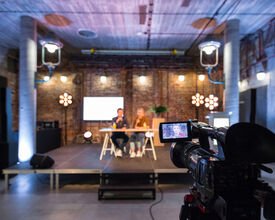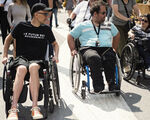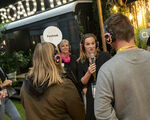Evenementen = samenhang. Het is simpel: een zwakke structuur en een zwakke rode draad leidt tot zwakke resultaten. Dit geldt voor zowel fysieke als online events.
Fysieke evenementen hebben een editoriale niche nodig om een bepaalde groep van bezoekers aan te trekken. Online evenementen, langs de andere kant, zijn zoveel meer dan webinars, die meestal over één onderwerp gaan. Online events hebben ook een duidelijke structuur en een helder programma nodig dat rond een specifiek onderwerp draait en langs verschillende perspectieven wordt benaderd.
Als een eventprofessional en ondernemer vertelt Kevin Van der Straeten er dit over: "om de kracht van je evenement te versterken, kun je kiezen om het rond een centraal thema of verhaallijn te laten lopen. Die verhaallijn verbindt dan de verschillende elementen van het programma. Het kost je tijd en creativiteit om een origineel thema te bepalen, maar die inspanning is goud waard. Als je een interessant verhaal te vertellen hebt, dan steek je met kop en schouders boven de rest uit en onderscheid je jezelf van je concurrenten."
Soms maken mensen cruciale fouten als ze een programma samenstellen. Soms voegen ze at random topics toe die niet gealigneerd zijn met de rode draad van het verhaal, of ze negeren die editoriale lijn helemaal en voegen gewoon een paar gerelateerde onderwerpen samen. Sommigen maken een ronduit saai programma, volgepakt met ronde tafel gesprekken, en geen ruimte voor workshops, keynote speeches, culturele belevingen of netwerkmomenten. Een fantastisch programma is de lijm van je evenement! Het is precies jouw verantwoordelijkheid om ervoor te zorgen dat jouw programma boven al de andere uitstijgt, verschilt van de rest en de aandacht van je deelnemers vasthoudt. Hier is hoe je dat doet:
Tip 1: Bepaal één kernthema
Als je een programma creëert, dan heb je een centraal thema nodig. Hoe specifieker dit thema is, hoe beter. Bijvoorbeeld, je organiseert geen evenement over marketing, maar wel over een bepaald domein, zoals content marketing, digitale marketing of inbound marketing. Door slechts één topic te behandelen en dat zo concreet mogelijk te definiëren, aligneer je je eventagenda met de interesses en noden van je niche doelgroep. Zo verwatert je agenda niet, en blijf je gefocust op je startpunt!
Tip 2: Gebruik de prisma techniek om je kernthema te diversifiëren
Nu je je kerntopic hebt bepaald, hoe bouw je daar een volledige agenda rond? Probeer het eens met de prisma techniek. Zoals je wel weet, splitst wit licht op in verschillende kleuren als het door een prisma gaat. Deze techniek kun je ook toepassen op je thema door ernaar te kijken vanuit diverse hoeken. Laten we digitale marketing als voorbeeld nemen.
Een aanpak zou kunnen zijn je evenement op te delen in onderdelen die draaien rond hoe verschillende industrieën hun digitale marketing inzetten, zoals SaaS, e-commerce en financiële technologieën. Je kunt tijdens de sessies meerdere types digitale praktijken bespreken, zoals social media, belangenbehartiging van medewerkers, brand ambassadeurs enzovoort. De prisma techniek helpt je een specifieke aanpak te vinden om je kernonderwerp te vertalen naar verschillende kennissessies, ronde tafels en keynote speeches.
Tip 3: Creëer je programma samen met je sprekers
Een andere manier die je kunt gebruiken om een aantrekkelijk programma te creëren, is in gesprek gaan met je sprekers. Deel je kernthema, en de aanpak die je in je hoofd hebt. Vraag of ze ideeën hebben. En misschien verrassend, meestal hebben ze geweldige ideeën. Misschien dragen je sprekers zelfs bij tot een totaal andere aanpak die leidt tot een volledig ander perspectief voor je deelnemers.
Tip 4: Zorg voor verschillende activiteiten
Key is je programma voldoende luchtig te houden. Dus niet meerdere kennissessies na elkaar zonder (virtuele) breaks of koffiepauzes. Langs de andere kant, een hele dag netwerken is ook te veel van het goede. Ook is het niet aangewezen om op één dag al je ronde tafels of al je workshops samen te organiseren. Mix de verschillende dynamieken en voorzie voldoende breaks en netwerk mogelijkheden zodat je deelnemers zich niet gaan vervelen.
In het kort
Je programma is de belangrijkste bouwsteen van je evenement! Hier bouw je je hele dynamiek rond, dus neem je tijd en plan dit zorgzaam. Begin met een kernthema vast te leggen, vernauw dit zo veel mogelijk. Zo organiseer je een aantrekkelijk evenement voor een specifieke doelgroep. Gebruik dan de prisma techniek om je aanpak te bepalen en deel je topic op in verschillende perspectieven. Om dit proces efficiënter te maken, betrek je sprekers en laat hen ideeën en hoofdlijnen aandragen. Ten slotte, mix dynamieken en activiteiten zodat je publiek niet in slaap valt. Als je deze tips over je eventprogramma toepast, dan focus je je inspanningen op iets memorabel en aantrekkelijk voor je gasten!
Engels
Events need coherence. Lacking a strong structure and a good editorial line will lead to poor results. This is true for both physical and online events. Physical events need a core editorial niche to attract a certain type of attendees. Online events, on the other hand, are so much more than webinars, which tend to focus on only one topic. Compared to webinars, an online event also needs structure and a clear program that revolves around a specific subject tackled from multiple perspectives.
As event professional and entrepreneur Kevin Van der Straeten notes, “To strengthen the objective of your event, you can choose to work with a central theme or story line, which links the different elements in the programme. It takes time and creativity to develop an original theme of this kind, but it is certainly worth the effort, if you can pull it off. If you have an interesting story to tell, you will stand out from the crowd and will, therefore, be able to distinguish yourself from your competitors.”
Unfortunately, people will make crucial mistakes when creating a program for their physical or online events. They may add random topics to their event program that aren’t aligned with the editorial philosophy, or they may ignore the editorial line altogether and simply put together a few related topics. Or they may come up with an extremely boring event program by packing it exclusively with roundtable talks, without leaving any space for workshops, keynote speeches, cultural experiences, or networking. A fantastic program is the glue of your event, and it’s your responsibility to make sure that your program is outstanding, different from the rest, and will retain people’s interest. Here’s how you can do that:
Come up with one core topic
Whenever you create an event program, you need a central topic, and the more specific this topic is, the better. In other words, instead of running an event on marketing, taper it down to a particular type of marketing, such as content marketing, digital marketing, inbound marketing, or outbound marketing. By having only one core topic and making it as narrow as possible, you’re aligning your event agenda with the interests and needs your niche target group may have. It will also help you avoid diluting your event agenda and give you a focused starting point.
Use the prism technique to diversify your main topic
Now that you’ve chosen one main topic, how can you build your entire agenda around it? Try the prism technique. As you may know, white light splits into different colors when it goes through a prism. You can apply this same concept to your event topic by looking at it from different angles. Let’s take digital marketing as an example.
One approach is to break your event into sections about different industries, such as SaaS, E-commerce, financial technologies, etc., and the ways they use digital marketing. Or you can discuss the different types of digital marketing practices, such as social media, employee advocacy, brand ambassadors, etc. The prism technique will help you find a specific approach to circulate your core topic for multiple knowledge sessions, roundtables, and keynote speeches.
Collaborate with your speakers on creating the program
Another way to build an attractive event program is by talking to your speakers. Share the core topic with them, as well as the approach you want to take, and ask them to contribute any session ideas. In most cases, your speakers will have great ideas. They may even come up with a totally new approach to your core topic and provide an entirely different perspective to your attendees.
Make sure your program incorporates multiple activities
An important key element to consider when designing your event agenda is to switch things up a bit. Don’t offer multiple knowledge sessions one after another without a (virtual or physical) coffee break or dedicate an entire day to networking. Also, it’s not recommended to batch all of your sessions and, for example, pack one day with just roundtables and the second day with just workshops. Mix up the sessions, and don’t forget to add enough coffee breaks and networking opportunities so that your attendees don’t get bored.
Final thoughts: Your agenda is the building block of your event
Your agenda is the core element upon which you’ll build your entire event, so dedicating extra time to designing it is crucial. Start by choosing one core topic for your event and narrow it down as much as possible. This will help you create an appealing event for a very specific target group. Then, use the prism technique to decide the approach you’ll be taking and break your topic into different perspectives. To make this process more efficient, open the conversation with your speakers and let them contribute with ideas and headlines. Finally, make sure to mix up the activities to keep your event coherent and avoid tiring or boring your guests. Apply these tips when designing your event agenda and focus your efforts on creating something truly memorable and attractive for your guests.






